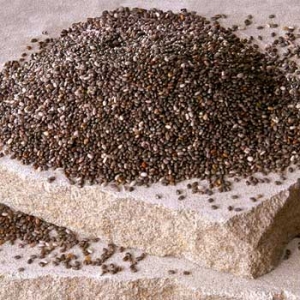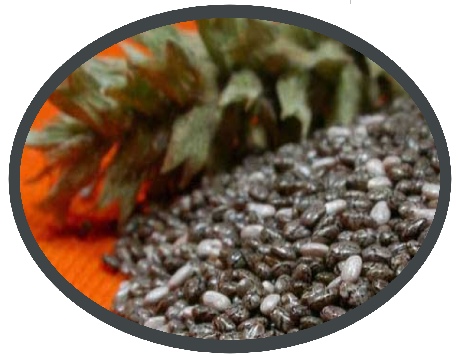


This year is definitely the year of the chia seeds.
Across time seeds have preceded all agriculture. Seeds are a very rich and important food source since mankind started farming 11 thousand years ago. We are referring to corn, wheat, rice, legumes and oilseeds, all of them within the seed group, so familiar to us and part of our food pattern.
In the later years new seeds have become available, such as flax, sesame, poppy, chia, etc. However, they are not new at all: they have been used for many centuries by ancient people like the Maya and the Aztec and are now fortunately being re-discovered because of their nutritional value.
Seeds are generally a good source of protein, minerals, fibre, etc. Chia has been getting a lot of attention because of all the nutritional characteristics that are attributed to it, especially the fibre, mineral and omega 3 fatty acid contents. And it is indeed a fair recognition. Chia has 5 times more calcium than milk, 5 times more polyunsaturated fat than salmon, 14 times more magnesium than broccoli, 2 times more potassium than bananas, more iron than spinach, more fibre than flax and more protein than any other cereal or grain, being equivalent to meat. Chia contains an almost complete array of essential amino acids, only lacking taurine, and has an antioxidant potential similar to some brands of supplements sold by pharmaceuticals.
It's worth looking at chia’s fats, which are the healthy type. Chia is one of the richest sources of omega 3 and it’s omega 6/omega 3 ratio is the ideal, 3 to 1, a rare exception! The balance between those fatty acids is a fundamental health factor. In the western food pattern a 15/1 ratio regarding those fatty acids is the most common (the best ratio would be less than 6/1), which is associated with heart disease, cancer and immune diseases. So, adding polyunsaturated fats with the ideal ratio to our daily food is good to prevent ischemic disease, allergies, type 2 diabetes, high cholesterol, high triglycerides, etc. Omega 3 is also associated to a better intellectual performance, being fundamental to children, students and during pregnancy.
Chia’s high fibre concentration helps weight loss because the seeds have the ability to absorb large quantities of water, which controls appetite. In fact, chia’s success lies in this very characteristic and it is being used by many people who wish to loose weight because it is also less expensive and healthier than chemicals which inhibit appetite. To obtain this effect you can mix a tablespoon chia seeds in a glass of water (250ml), let sit for a few minutes and drink 15 to 30 minutes before a meal to feel satiated. You should not overdue the dose because too much fibre can cause constipation and/or stomach cramps. Being extremely rich in fibre, chia seeds regulate bowel movements (in adequate quantities), which is also important in weight loss diets.
Being very rich in minerals, it also helps in restrictive diets, because it assures a good quantity of those nutrients that can be compromised in such diets.
 Rich in antioxidants
Rich in antioxidantsChia seeds contain high levels of antioxidants (chlorogenic acid, caffeic acid, myricetin, quercetin and flavonoids), turning them into a potentially anti-inflammatory food as well as a disease preventer, including tumour prevention.
There are studies(1) which point out that chia-based drinks can work as isotonic drinks for athletes, replacing the current ones (with high sugar levels) and improving performance. Studies also show that taking chia after intense exercise, due to the high soluble fibre content, makes hydration easier (by retaining water) and restoring minerals.
Chia can be found in whole seed, oil and flour. The choice depends on the goal. It should be taken into consideration that the flour contains protein and fibre but not the omegas. The oil has no fibre although it's very rich in omegas and it can be used to season salads. The whole seeds are rich in all the mentioned compounds and can be added to yoghurt, muesli, granola, soup, smoothies, pasta, cookies and cakes.
With all those advantages, chia can be considered a functional food and assist in the quest for better health.
Written by Cláudia Maranhoto, dietitian.
Translated by Ana Soares.
References:
(1) Illian TG, Casey JC, Bishop PA. Human Performance Laboratory, Department of Kinesiology, The University of Alabama, Auburn, Alabama, USA. Omega 3 Chia seed loading as a means of carbohydrate loading. Journal of Strength and Conditioning Research. 2011 Jan;
Insert date: 2013-04-28 Last update: 2013-05-31
Comment
![]()
![]()
Cereals and Seeds
Authors > Contributor writers > ClŠudia Maranhoto
Authors > Translators > Ana Soares